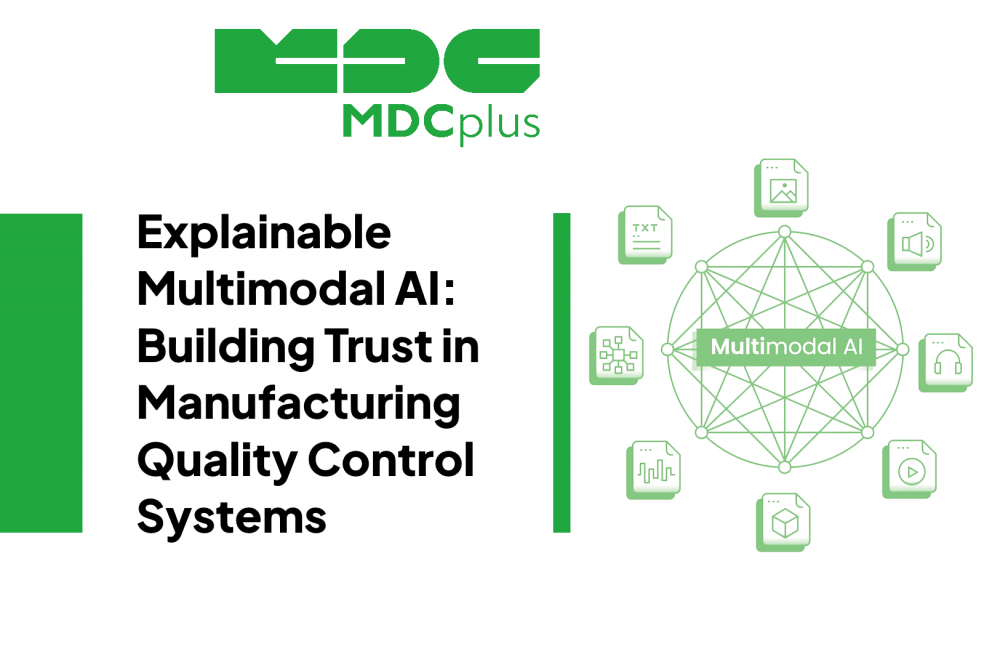Explainable Multimodal AI: Building Trust in Manufacturing Quality Control Systems
Artificial intelligence is reshaping manufacturing at a pace few predicted. One of the most promising applications is multimodal AI—systems that combine vision, sound, vibration, temperature and other sensor inputs to deliver a holistic view of production. Instead of relying on a single stream of data, multimodal systems fuse information from multiple channels, giving them the ability to detect defects earlier, prevent costly errors, and speed up inspections.
Imagine a welding robot on an automotive line. A human inspector may rely only on visual checks, but multimodal AI listens to the sound of the arc, monitors the heat profile, and reviews the weld image in real time. If porosity forms or the seam starts to deviate, the system flags it instantly. Similar approaches are being used for turbine blades in aerospace, pill coating in pharmaceuticals, and component assembly in electronics. The appeal is obvious: higher accuracy, fewer surprises at end-of-line testing, and reduced scrap.
Yet for all this promise, a problem remains. These systems are often opaque. They deliver results—“accept” or “reject”—without explaining why. In highly regulated industries, that black-box approach is unacceptable. Operators need to know the reason behind a decision. Regulators demand traceability. Engineers need clarity to improve the process. Without explainability, adoption slows and trust breaks down.
From Black Boxes to Transparent AI
The lack of transparency is the biggest obstacle standing in the way of widespread multimodal AI adoption. Most of today’s models are built on deep learning or transformer architectures. They may deliver impressive accuracy, but their decision-making process is hidden. A camera feed may identify a turbine blade as defective, but without a clear explanation, operators second-guess the result. Compliance officers refuse to sign off. Production managers see delays instead of benefits.
This is where explainable AI (XAI) changes the equation. Rather than leaving decisions locked inside a neural network, explainable systems surface the reasoning behind each flag. They highlight the exact weld seam pixels that showed irregular heating. They isolate the acoustic frequency that signaled porosity. They visualize the vibration pattern that pointed to a failing bearing. By doing so, they transform AI from an unaccountable authority into a practical tool operators can understand, trust, and act upon.
Explainability also provides confidence beyond the factory floor. In regulated sectors like aerospace and pharmaceuticals, audit trails are mandatory. An AI that can generate human-readable reports with confidence scores and cause annotations is not only more useful—it is more compliant. Manufacturers who adopt these systems position themselves ahead of tightening regulatory demands.
Explainability in Real-World Use
The impact of explainable multimodal AI is already visible across industries. Aerospace firms are using explainable inspection models for turbine blades, where a failed part can mean catastrophic risk. With XAI, regulators reviewing a quality control log can see not just that a blade was rejected, but the precise imaging and sensor data that justified the decision.
Pharmaceutical manufacturers face a similar challenge. Coating consistency for tablets must be documented for FDA audits. A black-box rejection is insufficient, but a multimodal AI that shows which image regions of a pill surface deviated from spec—and ties that to vibration or flow anomalies—meets both efficiency and compliance requirements.
In the automotive sector, explainability reduces costly false alarms. A traditional vision-only inspection system may incorrectly flag spot welds due to lighting variations or surface imperfections. A multimodal system cross-checks visual input with sound and temperature, and if it does raise a flag, it produces a traceable log explaining why. Engineers can then adjust welding parameters without halting the line unnecessarily.
These examples illustrate the broader point: explainability is not a “nice-to-have.” It is the foundation of trust. By showing its work, AI wins over skeptical operators, passes regulatory checks, and creates a closed feedback loop for process improvement.
The Road Ahead for Manufacturers
For manufacturers considering multimodal AI, the roadmap is becoming clearer. The first step is to pilot explainable systems at high-value inspection points, where transparency matters most. From there, companies should demand vendors provide explainability as a core feature, not an add-on. Integration with MES and ERP systems is crucial, ensuring that every AI decision becomes part of an auditable digital record.
The next frontier will be combining explainable multimodal AI with digital twins. By simulating not only physical processes but also the reasoning paths behind AI decisions, digital twins can validate inspection logic before deployment. This accelerates adoption and builds confidence that AI models are both accurate and accountable.
Ultimately, success in AI-driven quality control will not be measured only by how many defects are caught. It will be measured by how much trust the system earns from operators, engineers, regulators and customers. Manufacturers who adopt explainable multimodal AI today are not just improving inspection—they are future-proofing their operations against regulatory shifts, compliance risks, and competitive pressure.
Multimodal AI has the potential to revolutionize quality control in manufacturing, but without transparency it risks being sidelined as an untrusted black box. Explainability transforms these systems into accountable partners on the shop floor. By showing how and why decisions are made, explainable AI ensures that manufacturers achieve not only higher accuracy but also regulatory compliance and operator trust.
In a market where downtime, recalls, and compliance failures cost billions, the message is straightforward: the manufacturers who can both detect and explain will define the next era of smart, resilient production.
About MDCplus
Our key features are real-time machine monitoring for swift issue resolution, power consumption tracking to promote sustainability, computerized maintenance management to reduce downtime, and vibration diagnostics for predictive maintenance. MDCplus's solutions are tailored for diverse industries, including aerospace, automotive, precision machining, and heavy industry. By delivering actionable insights and fostering seamless integration, we empower manufacturers to boost Overall Equipment Effectiveness (OEE), reduce operational costs, and achieve sustainable growth along with future planning.
Ready to increase your OEE, get clearer vision of your shop floor, and predict sustainably?
